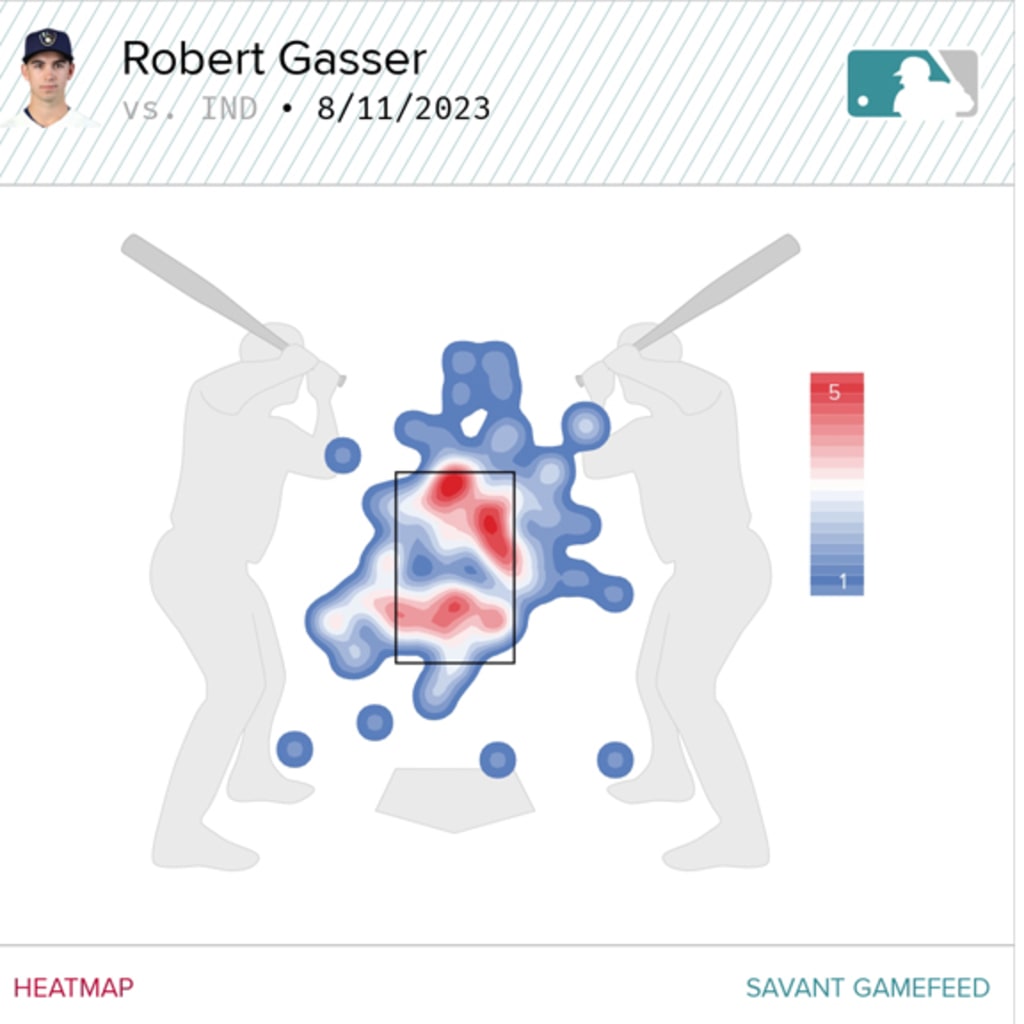There is a lot of talk about how Jackson Chourio, Sal Frelick, Jeferson Quero, Jacob Misiorowski and Tyler Black have taken nice jumps forward in 2023 and helped the Brewers establish the No. 3 farm system in all of baseball. But one player near the top of the club’s Top 30 Prospects list has the chance to make a unique impact for the Major League team this fall as it pursues its fifth postseason appearance in the last six years: left-hander Robert Gasser.
Milwaukee’s No. 6 prospect has spent the entire 2023 campaign with Triple-A Nashville, and entering Aug. 21, he had racked up 143 strikeouts in 113 1/3 innings, giving him 23 more K’s than anyone else at the Minors’ top level. His 3.81 ERA also ranked second among qualifiers in a year in which offense has jumped across Triple-A.
“I feel close,” Gasser said from the MLB Pipeline Game of the Month in Nashville back in July. “I feel like my games were in a good spot. I feel like I’ve grown a lot over this year. I started off the year not very good, walking a ton of guys. But for the past month and a half or so, I’ve cut down the walks a ton, thrown a lot more strikes and the strikeout numbers are still pretty good. As long as I can keep guys off the basepaths, I think I’ll be in really good shape.”
For this edition of the Pitching Lab, the 24-year-old southpaw walked MLB Pipeline through the grips and approaches he uses on the five pitches he features -- four-seamer, two-seamer, slider, cutter, changeup. In the video breakdown above, we’ve used footage from Gasser’s quality start from Aug. 11 in which he struck out nine and scattered three earned runs on three hits and two walks over six frames against Indianapolis.

Fastballs
Gasser throws a pair of heaters in his four-seam and sinker, both of which sit around 91-94 mph but with different movement profiles.
The four-seamer averages around 8-9 inches of horizontal break and roughly 14 inches of induced vertical break, which doesn’t make it a perfect “rising” fastball by modern standards but it does offer him an option up in the zone.
The sinker can generate 15-16 inches of horizontal movement to Gasser’s arm side, a performance that is aided by his lower arm slot. He’s actually increased its usage as 2023 has rolled along and the Triple-A feedback continues to be strong.
“It's a really good pitch early in counts for me,” Gasser said of the two-seamer. “I actually threw it a decent amount later in the count as well [on July 22], but early in the count -- especially with the cutters too -- having those two split the middle of the plate and having hitters guessing – that’s been my go-to early right now.”
True to his scouting report, Gasser threw first-pitch strikes to 16 of the 23 batters he faced in that Aug. 11 outing, and 12 of the 16 strikes came on either a fastball or a cutter. The two-seamer has also generated a ground ball on 51.3 percent of batted balls in play and hasn’t generated an extra-base hit all season, as of Aug. 21.
Cutter
Speaking of the cutter, Gasser joined the modern revolution around the pitch shortly after San Diego selected him as the 71st overall pick in 2021 out of Houston, starting with a four-seam grip and twisting the ball slightly for more offset positioning.
“In college, I didn’t even have it,” he said. “When I first got to pro ball, I wanted to throw a harder slider, and that was the pitch I gravitated toward. Over my first year and then into this year, it’s developed into a true cutter, which has been beneficial because it can keep guys off balance and I can have something that’s not going both directions horizontally. It’s kind of a bullet straight at the guy.”
Gasser’s comfort with the upper-80s pitch has become obvious, and there have been outings for Nashville -- particularly since late May -- when his cutter usage has surpassed his combined fastball totals. That correlates well with his improvement in control as Gasser hasn’t walked more than three batters in an outing since May 19.
As the hurler mentioned, Gasser’s cutter hovers right around the 0-inch mark for horizontal movement, though it can drift towards slider movement if he gets too on the side of the ball in his grip. Having a pitch he can pinpoint directly to the catcher’s mitt, instead of having to account for break or run, is a solid way to get back in counts or steal early strikes.
Slider
While Gasser can certainly throw the kitchen sink at hitters, it helps to have a true plus pitch, and that comes in the form of his 79-82 mph slider. (Note: this can appear as a curveball in Statcast’s Triple-A data set, but Gasser confirmed he throws the slider.)
While the two-seamer breaks 16 inches to Gasser’s arm side, the slider moves the same amount to his right (glove side), creating a slower mirror image of the sinking heater that befuddles batters from both sides.
“I take the horseshoe, wrap my fingers around it and have a lot of pressure on it [as] I grip it pretty hard,” he said. “It really depends on where I’m trying to throw it. I can throw it middle and start it at a lefty’s hip and get takes on that. Or if the circumstance calls for it, I can go backfoot to a righty.
“It has a lot of lift on it too. It has 10 induced vertical at times. So it can have lift and run. But if I turn it a little in my hand and think curveball and get that middle finger on top of it, it has a little more depth. But it’s a true slider since it gets 16-20 inches of horizontal. So I like that a lot, especially with some lift because nobody’s bat path is going up and to the left.”
In the Aug. 11 start against Indianapolis, Gasser threw 29 sliders and 17 of them (58.6 percent) resulted in called strikes or whiffs. That’s nearly double the “good” standard of 30 percent. Taking that comment about backfooting to right-handers on step further, too, Gasser did allow all nine of his homers in 2023 to righties, but he’s holding those same batters to a collective .226/.310/.386 line, fairly similar to the .233/.337/.322 line for lefties.
Changeup
“Work in progress right now,” were Gasser’s first words about his upper-80s changeup, which he throws with a two-seam grip with his middle fingers slightly offset on the left side of the laces.
At its best, the offspeed offering can show decent run, diving arm side around 16-20 inches while generating a lot of ground balls like the sinker. But that only goes so far.
“Honestly, it’s more of a location thing right now rather than the movement or profile,” Gasser said in July. “The profile is great. I have to figure out where to start the ball and get it in the zone more often.”
During the Indianapolis start, Gasser threw only six changeups total and didn’t get a called strike or whiff on any of them. Two of them resulted in 306-foot and 354-foot flyouts, both by right-handed slugger Miguel Andujar on cambios low but over the heart of the plate.
A more consistently located changeup would give Gasser a third quality pitch with good amounts of east-west movement -- nearly perfect for someone with his arm slot and lack of stellar fastball velocity. As is, the southpaw’s arsenal has been deep enough to punish Triple-A batters, and whether it’s late in 2023 or early in 2024, the Brewers should give the well-rounded repertoire a shot at The Show before long.
